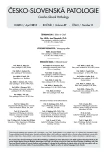Fibrosing cholestatic hepatitis – disease not only of transplanted patients. A report of eight cases
Authors:
E. Honsová 1; J. Šperl 2
Authors place of work:
Pracoviště klinické a transplantační patologie, Transplantcentrum IKEM, Praha
1; Klinika hepatogastroenterologie, Transplantcentrum IKEM, Praha
2
Published in the journal:
Čes.-slov. Patol., 47, 2011, No. 2, p. 55-58
Category:
Původní práce
Summary
Fibrosing cholestatic hepatitis (FCH) is a rapidly progressive, sometimes fatal form of hepatitis B or C in patients who are under immunosuppressive treatment. This condition was originally described in hepatitis B virus-infected recipients after a liver transplantation. It is characterized clinically by cholestatic hepatic dysfunction, and pathologically by marked hepatocyte swelling, cholestasis, periportal peritrabecular fibrosis, and only mild inflammation. Here we present 8 patients with hepatitis B and C related FCH. Three patients developed FCH after liver transplantation, two of them died due to hepatic failure. One recipient of a kidney/pancreas transplant developed “de novo” hepatitis C with features of FCH. He underwent antiviral treatment and survived with good liver function, unfortunately both of his grafts failed. Four patients suffered from a reactivation of their respective hepatitis B infections after chemotherapy treated hematological malignancy. Three of them needed an urgent liver transplantation and survived with good liver function and with a remission of their hematological diseases. The last patient died due to liver failure. Although FCH is a rare variant of viral hepatitis, it should be emphasized that prompt diagnosis is important for the management of patients.
Keywords:
fibrosing cholestatic hepatitis – viral hepatitis B – viral hepatitis C
Zdroje
1. Davies SE, Portmann BC, O’Grady JG, et al. Hepatic histological findings after transplantation for chronic hepatitis B virus infection, including a unique pattern of fibrosing cholestatic hepatitis. Hepatology 1991; 13: 150–157.
2. OęGrady JG, Smith HM, Davies SE, et al. Hepatitis B virus reinfection after orthotopic liver transplantation. Serological and clinical implications. J Hepatol 1992; 14: 104–111.
3. Lam P, Wachs M, Somberg K, et al. Fibrosing cholestatic hepatitis in renal transplant recipients. Transplantation 1996; 61(3): 378–381.
4. Delgado J, Munoz de Bustillo E, Ibarrola C, et al. Hepatitis C virus related fibrosing cholestatic hepatitis after cardiac transplantation: is azathioprine a contributory factor? J Heart Lung Transplant 1999; 18: 607–610.
5. Kojima H, Abei M, Takei N, et al. Fatal reactivation of hepatitis B virus following cytotoxic chemotherapy for acute myelogenous leukemia: fibrosing cholestatic hepatitis. Eur J Haematol 2002; 69: 101–104.
6. Yeo W, Chn T, Leung N, et al. Hepatitis B virus reactivation in lymphoma patiens with prior resolved hepatitis B undergoing anticancer therapy with or without rituximab. J Clin Oncol 2009; 27(4): 605–611.
7. Kusumoto S, Tanaka Y, Mizokami M, Ueda R. Reactivation of hepatitis B virus following systemic chemotherapy for malignant lymphoma. Int J Hematol 2009; 90: 13–23.
8. Demetris AJ. Evolution of hepatitis C virus in liver allografts. Liver Transpl 2009; 15(Suppl 2): 35–41.
9. Xiao SY, Lu L, Wang H. Fibrosing cholestatic hepatitis: Clinicopathologic spectrum, diagnosis and pathogenesis. Int J Clin Exp Pathol 2008; 1: 396–402.
Štítky
Patologie Soudní lékařství ToxikologieČlánek vyšel v časopise
Česko-slovenská patologie

2011 Číslo 2
Nejčtenější v tomto čísle
- Fibrotizující cholestatická hepatitida – onemocnění nejen transplantovaných pacientů
- JAKÁ JE VAŠE DIAGNÓZA?
- 70-roční jubileum Doc. MUDr. Jaroslava Horáčka, CSc.
- Životní jubileum prof. Josefa Špačka
Zvyšte si kvalifikaci online z pohodlí domova
Současné možnosti léčby obezity
nový kurzVšechny kurzy
